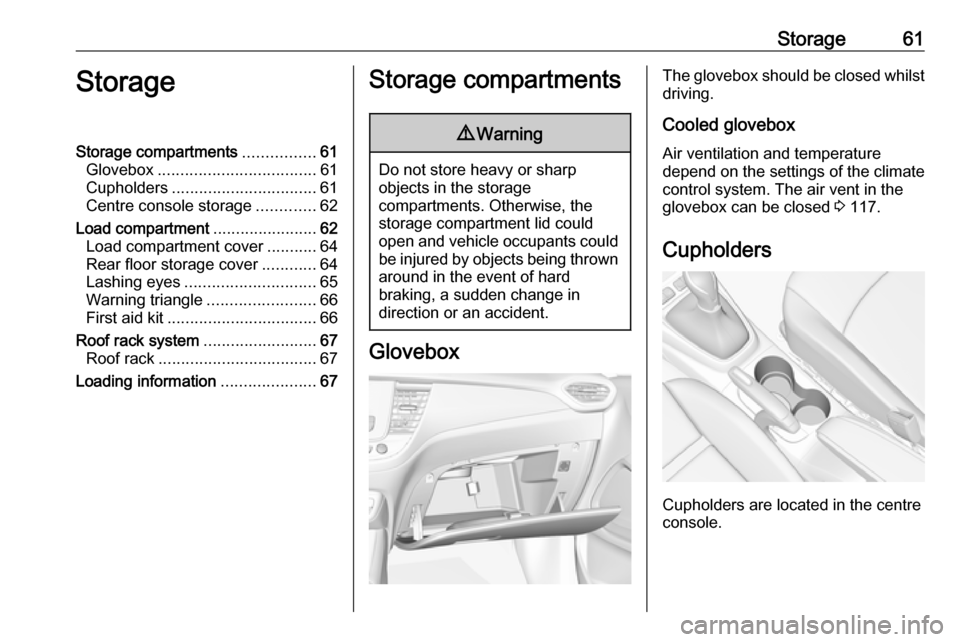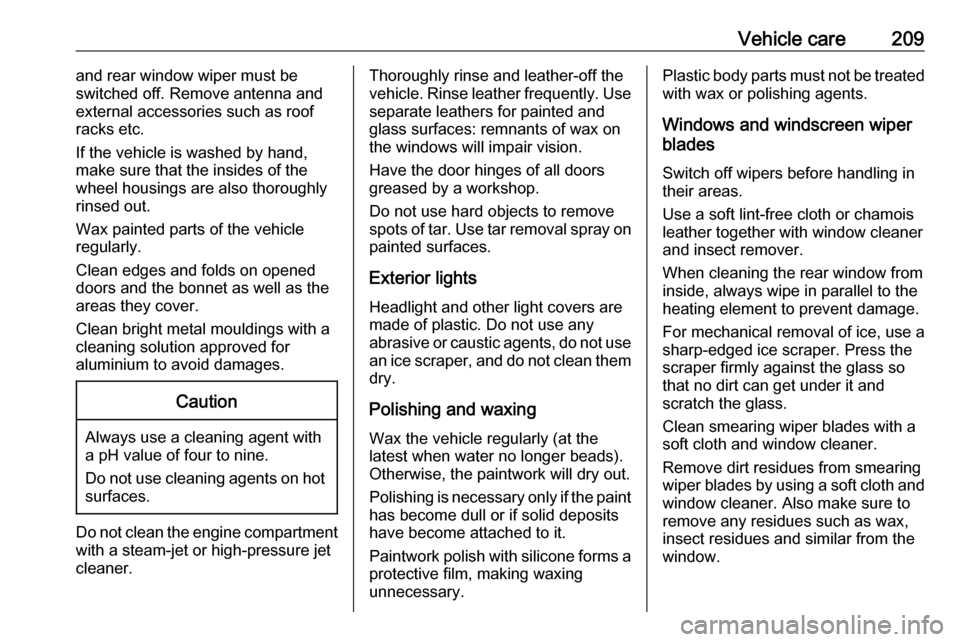2019.75 VAUXHALL CROSSLAND X roof rack
[x] Cancel search: roof rackPage 63 of 247

Storage61StorageStorage compartments................61
Glovebox ................................... 61
Cupholders ................................ 61
Centre console storage .............62
Load compartment .......................62
Load compartment cover ...........64
Rear floor storage cover ............64
Lashing eyes ............................. 65
Warning triangle ........................66
First aid kit ................................. 66
Roof rack system .........................67
Roof rack ................................... 67
Loading information .....................67Storage compartments9Warning
Do not store heavy or sharp
objects in the storage
compartments. Otherwise, the
storage compartment lid could
open and vehicle occupants could be injured by objects being thrown
around in the event of hard
braking, a sudden change in
direction or an accident.
Glovebox
The glovebox should be closed whilst driving.
Cooled glovebox
Air ventilation and temperature
depend on the settings of the climate
control system. The air vent in the
glovebox can be closed 3 117.
Cupholders
Cupholders are located in the centre
console.
Page 69 of 247

Storage67Roof rack system
Roof rack For safety reasons and to avoiddamage to the roof, the vehicle-
approved roof rack system is
recommended.
Follow the installation instructions
and remove the roof rack when not in
use.
Mounting roof rack
Open all doors.
Mounting points are located in each
door frame of the vehicle body.
Detach the cover from each mounting
point and fasten the roof rack with the attached screws.Loading information
● Heavy objects in the load compartment should be placed
against the seat backrests. Make
sure that the backrests are
securely engaged 3 62 . If objects
can be stacked, heavier objects
should be placed at the bottom.
● Prevent sliding of loose objects by securing them with straps
attached to the lashing eyes
3 65.
● Do not allow the load to protrude above the upper edge of the
backrests.
Page 70 of 247

68Storage● Do not place any objects on theload compartment cover or theinstrument panel, and do notcover the sensor on top of the
instrument panel.
● The load must not obstruct the operation of the pedals, parking
brake and gear selector, or
hinder the freedom of movement
of the driver. Do not place any
unsecured objects in the interior.
● Do not drive with an open load compartment.9Warning
Always make sure that the load in
the vehicle is securely stowed.
Otherwise objects can be thrown
around inside the vehicle and
cause personal injury or damage
to the load or car.
● The payload is the difference between the permitted gross
vehicle weight (see identification
plate 3 219) and the EC kerb
weight, refer to the EEC
Certificate of Conformity
provided with your vehicle or
other national registration
documents.
To calculate the payload, enter the data for your vehicle in the
weights table at the front of this
manual.
The EC kerb weight includes
weights for the driver (68 kg),
luggage (7 kg) and all fluids (fuel
tank 90% full).
Optional equipment and
accessories increase the kerb
weight.
● Driving with a roof load increases
the sensitivity of the vehicle to
cross-winds and has a
detrimental effect on vehicle
handling due to the vehicle's
higher centre of gravity.
Distribute the load evenly and
secure it properly with retaining
straps. Adjust the tyre pressure
and vehicle speed according to
the load conditions. Check and
retighten the straps frequently.
Do not drive faster than 75 mph.
The permissible roof load is
60 kg. The roof load is thecombined weight of the roof rack and the load.
Page 149 of 247

Driving and operating147more sensitive. Therefore, pressing
the brake pedal less strongly results
in immediate hard braking. This
function helps the driver brake
quicker and harder before the
imminent collision.9 Warning
Active emergency braking is not
designed to apply hard
autonomous braking or to
automatically avoid a collision. It is designed to reduce the vehicle
speed before a collision. It may not
react to animals. After a sudden
lane change, the system needs a
certain time to detect the next
preceding vehicle.
The complete attention of the
driver is always required while
driving. The driver must always be
ready to take action and apply the brakes and steer to avoid
collisions.
The system is designed to work with
all occupants wearing their seat belts.
Forward collision alert 3 144.
Front pedestrian protection 3 148.
System limitations In some cases, the active emergencybraking system may provide an
automatic braking in situations that
seem to be unnecessary, for instance
in parking garages, due to traffic signs in a curve or due to vehicles in
another lane. This is normal
operation, the vehicle does not need
service. Firmly apply the accelerator
pedal to override the automatic
braking if the situation and the
surroundings permit.
In the following cases, active
emergency braking performance is limited:
● driving on winding or hilly roads
● detecting all vehicles, especially vehicles with a trailer, tractors,
muddy vehicles, etc.
● detecting a vehicle when weather
limits visibility, such as in fog,
rain, or snow
● driving in the dark
● windscreen damaged or stickeredComplete attention is always required
while driving, and you should be
ready to take action and apply the
brakes and / or steer the vehicle to
avoid crashes.
We recommend to deactivate the
system in the vehicle personalisation
in the following cases:
● when towing a trailer or caravan
● when carrying long objects on roof bars or a roof rack
● when the vehicle is being towed with the engine running
● when a spare wheel is fitted that is smaller than the other wheels
● before using an automatic car wash with the engine running
● before placing the vehicle on a rolling road in a workshop
● if the windscreen has been damaged close to the camera
● if the front bumper has been damaged
● if the brake lamps are not working
Active emergency braking can be
deactivated in the personalisation
menu 3 94. If deactivated, m
Page 211 of 247

Vehicle care209and rear window wiper must be
switched off. Remove antenna and
external accessories such as roof
racks etc.
If the vehicle is washed by hand,
make sure that the insides of the
wheel housings are also thoroughly
rinsed out.
Wax painted parts of the vehicle
regularly.
Clean edges and folds on opened
doors and the bonnet as well as the
areas they cover.
Clean bright metal mouldings with a
cleaning solution approved for
aluminium to avoid damages.Caution
Always use a cleaning agent with
a pH value of four to nine.
Do not use cleaning agents on hot surfaces.
Do not clean the engine compartmentwith a steam-jet or high-pressure jet
cleaner.
Thoroughly rinse and leather-off the vehicle. Rinse leather frequently. Use
separate leathers for painted and
glass surfaces: remnants of wax on
the windows will impair vision.
Have the door hinges of all doors
greased by a workshop.
Do not use hard objects to remove
spots of tar. Use tar removal spray on
painted surfaces.
Exterior lights
Headlight and other light covers are
made of plastic. Do not use any
abrasive or caustic agents, do not use an ice scraper, and do not clean them
dry.
Polishing and waxing
Wax the vehicle regularly (at the
latest when water no longer beads).
Otherwise, the paintwork will dry out.
Polishing is necessary only if the paint
has become dull or if solid deposits
have become attached to it.
Paintwork polish with silicone forms a
protective film, making waxing
unnecessary.Plastic body parts must not be treated with wax or polishing agents.
Windows and windscreen wiper
blades
Switch off wipers before handling in
their areas.
Use a soft lint-free cloth or chamois leather together with window cleaner
and insect remover.
When cleaning the rear window from
inside, always wipe in parallel to the
heating element to prevent damage.
For mechanical removal of ice, use a
sharp-edged ice scraper. Press the
scraper firmly against the glass so
that no dirt can get under it and
scratch the glass.
Clean smearing wiper blades with a
soft cloth and window cleaner.
Remove dirt residues from smearing
wiper blades by using a soft cloth and window cleaner. Also make sure to
remove any residues such as wax,
insect residues and similar from the
window.
Page 245 of 247

243QQuickheat ................................... 116
R
Radio Frequency Identification (RFID) ..................................... 238
Radio remote control ...................21
Rain sensor .................................. 86
REACH ....................................... 232
Reading lights ............................ 105
Rear floor storage cover ..............64
Rear fog light ...............86, 104, 183
Rear seats ................................... 45
Rear view camera ...................... 160
Rear window wiper and washer ..73
Recommended fluids and lubricants ........................ 217, 221
Refuelling ................................... 166
Registered trademarks ...............235
Reverse light............................... 183
Reversing lights .........................104
Ride control systems ..................137
Roadside assistance ....................97
Roof .............................................. 38
Roof load ...................................... 67
Roof rack ..................................... 67
S Safety belts ................................... 46
Seat adjustment ....................... 7, 42
Seat belt ........................................ 8Seat belt reminder .......................81
Seat belts ..................................... 46
Seat heating ................................. 44
Seat position ................................ 41
Selective catalytic reduction .......129
Selector lever.............................. 132
Service ............................... 118, 213
Service display ............................ 80
Service information ....................213
Service vehicle soon .................... 83
Side airbag system ......................52
Side blind spot alert ..............87, 156
Sidelights ...................................... 99
Side turn lights ........................... 187
Software acknowledgement .......232
Software update ......................... 234
SOS .............................................. 97
Spare wheel ............................... 201
Speed limiter......................... 87, 141
Speedometer ............................... 77
Starting and operating ................121
Starting off ................................... 16
Starting the engine ....................123
Steering ...................................... 121
Steering wheel adjustment ......9, 70
Steering wheel controls ...............70
Stop engine .................................. 83
Stop-start system........................ 125
Storage ......................................... 61
Storage compartments .................61Sun visor lights .......................... 106
Sun visors .................................... 38
Symbols ......................................... 4
System check ............................... 83
T
Tachometer ................................. 78
Tail lights ................................... 183
Three-point seat belt .................... 47
Through-loading facility ................62
Tools .......................................... 192
Tow bar....................................... 167
Towing ................................ 167, 206
Towing another vehicle .............207
Towing equipment .....................169
Towing the vehicle .....................206
Trailer hitch ................................. 167
Trailer towing ............................. 168
Transmission ............................... 16
Transmission display .................132
Tread depth ............................... 196
Trip odometer .............................. 78
Turn lights ............................ 81, 103
Tyre chains ................................ 197
Tyre deflation detection system . 195
Tyre designations ......................193
Tyre pressure ............................ 194
Tyre pressures ........................... 228
Tyre repair kit ............................. 197